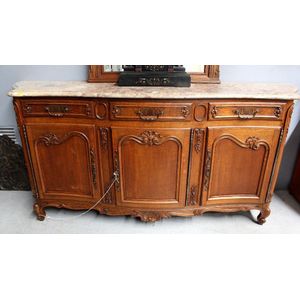Georgian Satinwood Inlaid Double Pedestal Sideboard
You must be a subscriber, and be logged in to view price and dealer details.
Subscribe Now to view actual auction price for this item
When you subscribe, you have the option of setting the currency in which to display prices to $Au, $US, $NZ or Stg.
- Rail - A term used by cabinet makers for the horizontal sections of the frame of an item such as a chair or settee which have a front rail, a back rail and two side rails, and also on a door or carcase, where the rails are joined to the vertical framings.
- Circa - A Latin term meaning 'about', often used in the antique trade to give an approximate date for the piece, usually considered to be five years on either side of the circa year. Thus, circa 1900 means the piece was made about 1900, probably between 1895 and 1905. The expression is sometimes abbreviated to c.1900.
- Inlay - Decorative patterns inserted into the main body of a piece of furniture, generally in wood of contrasting colour and grain, though brass, ivory, ebony, shell and sometimes horn have been used. Inlay may consist of a panel of well figured timber inset into a cabinet door front, geometric patterns, or complex and stylized designs of flowers, swags of foliage, fruits and other motifs. As a general rule, in pieces where the carcase is constructed in the solid, the inlay is relatively simple such as stringing, cross banding and herringbone banding. Where more elaborate and decorative work was required veneer was used. Inlay has been fashionable from at least the latter half of the 17th century, when a variety of elaborate forms were developed
- George Iii - George III (1738 - 1820) was King of Great Britain and Ireland from 1760 to 1820.
- Satinwood - Satinwood is a dense pale gold coloured timber that was imported into Britain in the second half of the 18th century, and early 19th centuries from the East Indies and the West Indies. The name derives from the satin-like surface sheen when the timber is polished.
It was used in the solid, as a veneer and in inlays. As well as furniture, satinwood was used for making musical instruments, barometers, boxes and clocks.
It will usually be found on only the very best quality objects, presumably because of of its cost at the time. - Mahogany - Mahogany is a dense, close grained red-coloured timber from the West Indies and Central America. It was first imported into Europe in the the early 18th century and its use continued through the 19th century. It was popular for furniture making because of its strength, the wide boards available, the distinctive grain on some boards, termed flame mahogany and the rich warm colour of the timber when it was polished.. The "flame" was produced where a limb grew out from the trunk of the tree, and this timber was usually sliced into veneers for feature panels on doors, backs and cornices.
Some terms used to describe mahogany relate to the country from which it originally came, such as "Cuban" mahogany, "Honduras" mahogany etc. However unless the wood has been tested the names assigned are more a selling feature, rather than a true indication of the timber's origin.
This item has been included into following indexes:
- cabinets, material - satinwood 56
- cabinets, period or style - Georgian 272
-
sideboards
- Georgian 130
- twin pedestal style 131
Visually similar items

An Australian cedar pedestal sideboard, circa 1840, the triangular pediment back with foliate s-scrolled decoration to either end above a rectangular top over three drawers with rounded cushion fronts, the pedestals with tapering raised panels, enclosing s

French Louis XV style marble topped enfilade, 104 cm high, 215 cm long, 60 cm deep

A William IV mahogany servery table, circa 1820s, of fine restrained form with generous pedestals with canted tops above cellaret cupboards flanked by tapering columns, the concave central servery section with a low squared back and two frieze drawers, dec

A late Victorian inlaid rosewood davenport, late 19th century, in well figured timber, inlaid throughout with delicate arabesques and swag motifs, a galleried and fitted pen and paper compartment and the original tooled brown leather surface, the interior
